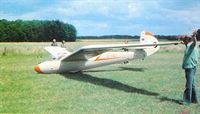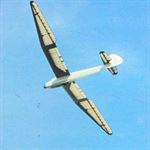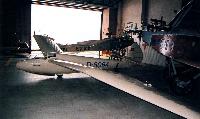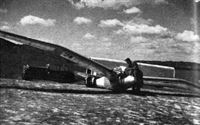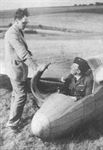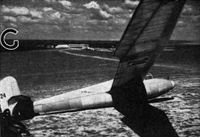
M.Simons The World's Vintage Sailplanes 1908-45
THE MINIMOA
Early in 1935 Martin Schempp and Wolf Hirth founded a new glider manufacturing company at Goeppingen, a small town about 50 km east of Stuttgart. They planned to make a whole range of gliders and sailplanes. The Goeppingen 3 was a performance sailplane based on Hirth’s successful Moazagotl. It was similar in appearance but had a cantilever wing and was smaller, hence it was nicknamed Mini Moazagotl which soon contracted to Minimoa.
The Minimoa was at first advertised with three different wingspans, 16, 17 and 18 metres, but the 17 metre version was the only one to be built in quantity. Initially, all had skids for landing, but soon a wheel was fitted except to one solitary 18 metre model which was produced later. The first few Minimoas had the wing mounted high on the fuselage, the pilot’s head being almost enclosed within the leading edge. The windscreen and transparent canopy faired neatly to the fuselage but restricted outward view severely. The prototype had an unusual control column, for Wolf Hirth had an artificial leg and it was always difficult for him to clamber into and out of cockpits with the usual ‘stick’ mounted just ahead of the seat. The first Minimoa had a stick suspended from its torque tube in brackets above the cockpit, hanging down in front of the pilot’s face. This arrangement was not popular and was abandoned in favor of the normal control system on all subsequent Minimoas.
The aerofoil section at the root was Goettingen 681, a less cambered profile than those used on many earlier sailplanes. Just outboard of the bend in the wing, where the ailerons were at their broadest, the profile changed to Goettingen 693 and thence to a thin symmetrical tip with washout.
To build the Minimoa wing was difficult. The mainspar was strongly ‘gulled’, and at the same time because of the curious planform, it had to curve backward from the same point as the ‘gull’ bend. This necessitated laminating the spars on rather elaborate forms. Errors in workmanship were easy to make but hard to detect. Some early production Minimoas flew one-wing-low since the spars of the two wings were not quite the same shape and subsequently much ingenuity was employed to prevent this. The bird-like wing was attractive, however, and the aircraft was very' stable. The prototype participated in the 1935 Rhoen meeting, where it demonstrated another new feature, split landing flaps along the underside of the wing running from the root to the ‘gull’ bend. Hirth performed brilliantly, flying on 27th July 420 km into Czechoslovakia, though he was a few days too late to claim the world record, Hofmann having flown 474 km in the Rhoensperber just a few days before.
Three of the high-winged Minimoas were built, the second being exported to Japan, the third to Romania. The prototype too went to Japan with Hirth, and remained behind when he returned.
Modifications were soon found to be necessary. The pendulum elevators were too sensitive at high speeds, and a fixed tailplane was introduced. In 1936, the wing was lowered on the fuselage, the cockpit canopy being redesigned so that for the first time the pilot now had a good view. A somewhat larger rudder was fitted. Upper surface wing spoilers replaced the split flaps which had proved rather awkward to use. The provision of water ballast, in a tank behind the cockpit, was advertised and the Minimoa was strong enough, with a load factor of 10 instead of the usual 8, to take the extra weight. It was in this form that the Minimoa entered quantity production and became known worldwide. The gracefully shaped wing caught the imagination of pilots and the general public alike and did a good deal to popularise the type. Examples were exported to most countries where any gliding was done; in the USA Lewin Barringer set the National distance record, in South Africa a Minimoa was used to raise the record in stages to well over 300 km and the height record to more than 3000 m. Eric Nessler in France climbed his Minimoa to over 3500 m, and in England Philip Wills became the third Gold ‘C’ pilot on the international list, and the first in England, with his record distance and altitude flights. His Minimoa was also used during the Battle of Britain to fly over the English Channel, towed by an aeroplane, to glide back to the coast to see if the early radar units could detect a wooden glider.
At the 19th Rhoen Competitions in 1938 in a field of 60 aircraft. 15 Minimoas were entered. Three of these finished in the top ten and on one day seven achieved distances over 300 km. On 3rd August, a Minimoa pilot struck such severe turbulence in cloud that he was thrown out of his aircraft as it broke up around him. His automatic parachute opened but he was amazed to find himself carried upward by the strong uprush of air within the cloud, then he descended, only to be swept up again. This happened several times until at last he was deposited, battered and chilled, on the ground. On 4th August, contestant Guenther Lemm climbed his Minimoa in cloud, without oxygen or blind flying instruments, to 4980 metres. In another Minimoa, Walther Frick, in similar conditions, reached 5500 metres. The official world altitude record was thus broken twice on one day. On 5th August huge cumulonimbus clouds drifted down upon the Wasserkuppe. Eighteen sailplanes are known to have entered one large cloud. Six broke up in flight or collided at great altitudes, two of them being Minimoas and Guenther Lemm, record breaker of yesterday, was killed. Altogether three men died, one of them Blech in the Horten 3 flying wing. Another who survived lost two fingers from frostbite. A solitary Minimoa, however, emerged triumphant. Walter Drechsel weathered hail and ice storms, maintained control in violent turbulence, and climbed until oxygen deficiency compelled him to turn out of the storm. He reached 6687 metres, landing late in the day far away from the Wasserkuppe. The record stood only three months.
The factory at Goeppingen continued building Minimoas, the later models being fitted with full airbrakes. Various other detail changes were made. Hirth was able to convert one model to a two-seater, the second pilot being housed in a cabin with the seat between main and secondary main fuselage frames. With this aircraft he visited England, but the type did not enter production. In 1939 the Minimoa '39 appeared, but only one was completed. All told, at least 100 Minimoas were built. Several still survive, some in museums, others in flying condition.
The performance was measured by the DFS and the weights and figures quoted below come from W. Spilger's report of 1938.
Technical data:
Minimoa 1936: Span. 17.00 m. Wing area. 19 sq m. Aspect ratio. 15.21. Empty weight. 228 kg. Flying weight. 353 kg. Wing loading. 17.5 kg/sq m. Aerofoils, root, Goettingen 681, midspan, Goettingen 693, tip, thin symmetrical with 10 degrees washout. Best glide ratio. 1 : 25.7 at 69.9 km/h. Minimum sinking speed. 0.70 m/sec at ,60.9 km/h. Sink at 100 km/h. 1.52 m/sec.
Описание:
- M.Simons The World's Vintage Sailplanes 1908-45
- M.Hardy. Gliders & Sailplanes of the world
Фотографии
-
GL / M.Simons - The World's Vintage Sailplanes 1908-45 /Kookaburra/
Регистрационный номер: D-1163 [2] This Minimoa now flies at Muenster. It was taken to France as war loot in 1945, but was retrieved from exile a quarter of a century later and restored by Max Muller for the Muenster group. It carries the name ‘Spatheimkehrer’ (late homecomer), a sobriquet applied to the prisoners-of-war who were not released from Russia until many years after the end of hostilities.
-
GL / M.Simons - The World's Vintage Sailplanes 1908-45 /Kookaburra/
Регистрационный номер: D-14-295 An historic photograph showing Wolf Hirth (right) and Martin Schempp (left) with a Minimoa produced on 30th June 1938. The aircraft has all the features of the later production models, air-brakes, partly moulded cockpit canopy and mass-balanced rudder. The color scheme is to the NSFK standard, registered to Region 14, Bavaria. There is some doubt as to whether this really was the 100th Minimoa, since a photograph exists showing a similar placard alongside another Minimoa, registered D-15-1090. Possibly both sailplanes left the factory on the same day and may have been used for publicity purposes.
-
GL / M.Simons - The World's Vintage Sailplanes 1908-45 /Kookaburra/
The Minimoa belonging to John Coxon, restored by Ken Fripp, seen here at Wycombe Air Park in 1972.
-
GL / M.Simons - The World's Vintage Sailplanes 1908-45 /Kookaburra/
The Coxon Minimoa in flight.
-
GL / M.Simons - The World's Vintage Sailplanes 1908-45 /Kookaburra/
A truly international picture. The Minimoa in the background is of German origin, the Moswey 3 is Swiss, the pilots and location are American. The photograph was taken over the famous soaring site at Harris Hill, Elmira, NY.
Другие самолёты на фотографии: Moswey 2 / 3 - Швейцария - 1936
-
Мировая Авиация 19
Регистрационный номер: D-8064 Устойчивость и безопасное управление планером Minimoa, впервые взлетевшим в 1935 году, обеспечивались наличием стреловидного крыла с поперечным V, большими элеронами и сбрасываемым водным балластом, размещенным в фюзеляже.
-
GL / M.Simons - The World's Vintage Sailplanes 1908-45 /Kookaburra/
Регистрационный номер: HB-282 [2] The Minimoa shown here is probably the oldest surviving, but was rebuilt with some late features after an accident. It has the small rudder of the early production version and the wings have less dihedral than was usual later. In spite of this, modern airbrakes are fitted instead of the original spoilers and a blown Perspex canopy has been used. It is painted in a metallic blue finish, and is owned by Werner von Arx.
-
Aeroplane Monthly 1999-10 / A.Welch - Veejay /Post-war civil/
Регистрационный номер: HB-438 A Schempp-Hirth Minimoa in Switzerland illustrates the type. Minimoas set a number of pre-war records, including a world altitude of 21,939ft.
-
GL / M.Simons - The World's Vintage Sailplanes 1908-45 /Kookaburra/
Taken at High Wycombe in 1971, this photograph shows, left to right, the nose of a Weihe, the Cantilever Gull or Kirby Gull 3, the Dunstable-based Minimoa and at the far end of the line, the Kirby Tutor.
Другие самолёты на фотографии: DFS Weihe - Германия - 1938Slingsby T.12 / T.14 / T.15 Gull - Великобритания - 1938Slingsby T.7 Kirby Cadet / T.8 Kirby Tutor / T.20 / T.31 - Великобритания - 1936
-
GL / M.Simons - The World's Vintage Sailplanes 1908-45 /Kookaburra/
An early production Minimoa with high wing, wheel, and split flaps. The very neat but perhaps claustrophobia-inducing cockpit enclosure was built up from six curved pieces of plastic, with other large rectangular windows in the roof. Note the slight curvature of the ailerons at their root end where they ran into the 'gull' wing curve. This feature remained on all later Minimoas. The wheel, fitted to all Minimoas after the prototype, was introduced to Germany by Hirth and Schempp following their experiences with autotow and winch launching in the USA.
-
Air Enthusiast 2007-03 / B.Norton - Ready for the Silent Assault /World war two/ (1)
TG-11, a record-setting Goppingen 3 Minimoa was previously owned by personnel closely associated with the Army glider programme and so, unlike the others, found its way to Wright Field to be photographed.
-
GL / M.Simons - The World's Vintage Sailplanes 1908-45 /Kookaburra/
Регистрационный номер: S-42 This Minimoa was flown post-war by a British Airforce of Occupation gliding club. The colors were red and cream with clear doped fabric and British roundels.
-
Aeroplane Monthly 1997-03 / D.Webb - Silent warriors /Tested & failed/
Регистрационный номер: BGA338 [2] Minimoa BGA338 at the London Gliding Club, Dunstable, in 1938-39.
-
Flight 1938-07 / Flight
Promising cumulus: Mr. Philip Wills, inveterate long-distance pilot, prepares the beautiful Minimoa
-
Flight 1939-07 / Flight
Mr. Philip Wills (with special altitude-rated hat) in the somewhat confined quarters of the Minimoa.
-
Aeroplane Monthly 1991-09 / M.Challinor - 60 years of Ups on the Downs
World champion Philip Wills gives the benefit of his experience to an RAF squadron leader before a flight in the spring of 1940.
-
Aeroplane Monthly 1999-10 / A.Welch - Veejay /Post-war civil/
Enthusiastic retrieval of the Minimoa after Ann gained her Silver distance from Salzgitter in May 1946. The aircraft is almost obscured by excited children.
-
Aeroplane Monthly 1997-03 / D.Webb - Silent warriors /Tested & failed/
Регистрационный номер: BGA338 [2] GRACE: The Minimoa sailplane in which Mr. Philip Wills has been putting up some fine performances, notably by establishing a British distance record or 206 miles and the British height record of over 10,000ft.
The first flight in England of Minimoa BGA338, at the London Gliding Club, Dunstable, on April 3, 1938. -
GL / M.Simons - The World's Vintage Sailplanes 1908-45 /Kookaburra/
Регистрационный номер: D-4-531 Minimoa D-4-531 after a bungee launch.
-
GL / M.Simons - The World's Vintage Sailplanes 1908-45 /Kookaburra/
Регистрационный номер: D-10-921 Minimoa D-10-921 with the swastika removed from the photograph to comply with post-war regulations.
-
GL 1982- / M.Hardy - Gliders and Sailplanes /Gliders & Sailplanes of the world/ (1)
Регистрационный номер: F-CADA EoN Olympia 419 (???)
-
GL / M.Simons - The World's Vintage Sailplanes 1908-45 /Kookaburra/
Регистрационный номер: N2664B One of the most famous of all sailplanes, the Minimoa, of which more than 100 were built between 1935 and 1939. Fewer than ten now survive but of these, five are airworthy. The example shown here belongs to Jan Scott in the USA. The canopy and nose had been modified.
-
GL / M.Simons - The World's Vintage Sailplanes 1908-45 /Kookaburra/
Регистрационный номер: D-1163 [2], HB-282 [2] Variation in rudders. The left hand example was the standard production type from the Muenster Minimoa D-1163 and that on the right from the older Swiss HB-282.
-
GL / M.Simons - The World's Vintage Sailplanes 1908-45 /Kookaburra/
Hirth trying out the cockpit and unusual control column arrangement of the high-wing prototype. Schempp looks on anxiously from behind.
- Фотографии
